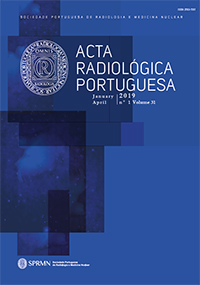Cancro do Cólon: chegou a altura da RM?
DOI:
https://doi.org/10.25748/arp.17766Resumo
Even if the only currently curative treatment for colon cancer is surgery, recently there has been a growing discussion about the benefit of neoadjuvant chemotherapy (nChT) for patients with locally advanced cancers at increased risk of recurrence, upon recognition of adverse prognostic factors. The first works about nChT in colon cancer have showed promising results.1-3 In specific, results from the FOXTROT trial, designed to evaluate the potential benefits of nChT for patients with locally advanced colon cancer, are greatly expected.1 If that treatment will become standard, pre-operative imaging will become a valuable tool to select patients for nChT.4
On the other hand, as some colon tumours are now surgically removed by laparoscopy, is important to recognize those patients in whom laparoscopy might not be appropriated, either because the tumor is bulky or locally advanced.5
Therefore, imaging could be important to select: 1) early cancers that may undergo surgical excision directly; 2) locally advanced cancers that may need nChT or require an open approach/radical surgery because of involvement of adjacent organs; and 3) metastatic cancers for which curative surgery is not primarily indicated.6 Traditionally, this selection has been performed by computed tomography (CT), but this method has some important limitations.7 As such, some recent works have focused on the role of magnetic resonance imaging (MRI) in colon cancer staging.4,6,8-10
Downloads
Publicado
Edição
Secção
Licença
CC BY-NC 4.0


